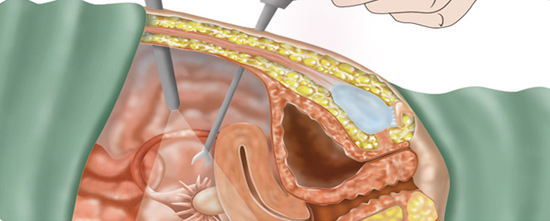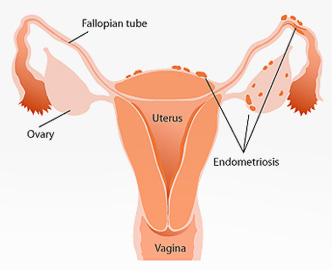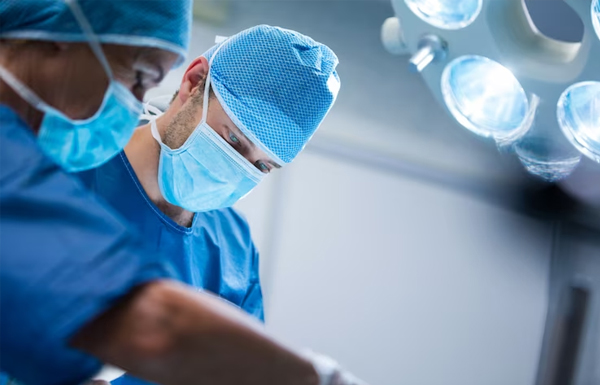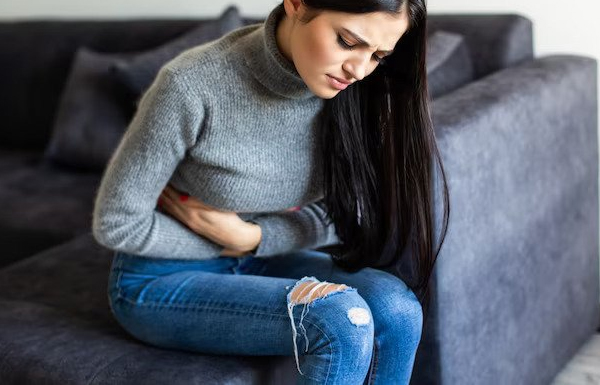Dr. Sankar Dasmahapatra
Endometriosis Doctor in Kolkata, India
DGO, MS, Fellowship in Gynaecological Lap Surgery (Sydney -Australia)
Consultant Gynaecologist & Obstetrician
Infertility Specialist & Lapaoscopic Surgeon
DGO, MS, Fellowship in Gynaecological Lap Surgery (Sydney -Australia)
Consultant Gynaecologist & Obstetrician
Infertility Specialist & Lapaoscopic Surgeon
What is Endometriosis?
Endometriosis (say "en-doh-mee-tree-OH-sus") is a problem many women have during their childbearing years. It means that a type of tissue that lines your uterus is also growing outside your uterus. This does not always cause symptoms. And it usually isn't dangerous. But it can cause pain and other problems.
The clumps of tissue that grow outside your uterus are called implants. They usually grow on the ovaries, the fallopian tubes, the outer wall of the uterus, the intestines, or other organs in the belly. In rare cases they spread to areas beyond the belly.

How does endometriosis cause problems?
Your uterus is lined with a type of tissue called endometrium (say "en-doh-MEE-tree-um"). Each month, your body releases hormones that cause the endometrium to thicken and get ready for an egg. If you get pregnant, the fertilized egg attaches to the endometrium and starts to grow. If you do not get pregnant, the endometrium breaks down, and your body sheds it as blood. This is your menstrual period. When you have endometriosis, the implants of tissue outside your uterus act just like the tissue lining your uterus. During your menstrual cycle, they get thicker, then break down and bleed. But the implants are outside your uterus, so the blood cannot flow out of your body. The implants can get irritated and painful. Sometimes they form scar tissue or fluid-filled sacs (cysts). Scar tissue may make it hard to get pregnant.
What causes endometriosis?
Experts don't know what causes endometrial tissue to grow outside your uterus. But they do know that the female hormone estrogen makes the problem worse. Women have high levels of estrogen during their childbearing years. It is during these years-usually from their teens into their 40s-that women have endometriosis. Estrogen levels drop when menstrual periods stop (menopause). Symptoms usually go away then.

What are the symptoms?
Some women with endometriosis don't have symptoms. Other women have symptoms that range from mild to severe. Symptoms may include:
1) Pain, which can be:
• Pelvic pain.
• Severe menstrual cramps.
• Low backache 1 or 2 days before the start of the menstrual period (or earlier).
• Pain during sexual intercourse.
• Rectal pain.
• Pain during bowel movements.
2) Infertility may be the only sign that you have endometriosis. Between 20% and 40% of women who are infertile have endometriosis
3) Abnormal bleeding. This can include:
• Blood in the urine or stool.
• Some vaginal bleeding before the start of the menstrual period.
• Vaginal bleeding after sex.
Symptoms are often most severe just before and during your menstrual period. They get better as your period is ending. Some women, especially teens, have pain all the time.
Several other conditions can cause symptoms that are similar to endometriosis. These conditions include painful periods,adenomyosis, and uterine fibroids.
Laparoscopic Endometriosis surgery treats mild to severe cases by skilled surgeons trained in this method. During the procedure, they'll make a small incision in your abdomen so they can insert a tiny tube with a camera (laparoscope) through it. In some cases, they may need to make more than one small incision.
How long is laparoscopic surgery for endometriosis?
Excision of endometriosis is a good option for you and we would expect your symptoms to improve post-operatively. Your operation will last about 1.5 - 2 hours.
What are the risks of endometriosis laparoscopic surgery?
Laparoscopy is relatively safe, but with all surgical procedures, there are risks involved, including: Internal bleeding. Hernia (a bulge caused by poor healing) at the incision sites.
What is the recovery time for endometriosis surgery?
The recovery time after endometriosis surgery varies from person to person. Most people will experience some pain and discomfort in the days following surgery. Laparoscopy recovery time typically lasts a few weeks, but may be longer for some people.

Can I walk after laparoscopy?
Most women should be able to walk slowly and steadily for 30-60 minutes by the middle of the first week, and will be back to their previous activity levels by the second week. Swimming is an ideal exercise and, if you have had no additional procedure, you can start as soon as you feel comfortable.
How many days rest after laparoscopy?
If you've had laparoscopy to diagnose a condition, you'll probably be able to resume your normal activities within 5 days.
Can endometriosis come back after laparoscopy?
Endometriosis can grow back soon after surgery if the disease isn't completely removed or if your ovaries aren't suppressed.
Is endometriosis cured after laparoscopy?
Studies have shown that five years after surgery, up to 70 per cent of women will have no evidence of endometriosis returning. Not all endometriosis can be treated with laparoscopy, however. Sometimes endometriosis affects other organs such as the bowel or ureter (the tube from the kidney to the bladder).
Can I get pregnant after laparoscopy for endometriosis?
Your Fertility after Laparoscopy for Endometriosis: What to Expect. The outlook for fertility after endometriosis surgery is very positive. Between 45 and 75% of women who undergo the surgery are able to conceive after healing. Many of these pregnancies are even achieved naturally.
Can you walk after endometriosis surgery?
Please pace your activity after surgery- the first week or 2 it's ok to take short walks, less than 15 minutes at a time. Between 2-4 weeks, you can start pushing yourself to walk farther and faster, but don't lift anything heavier than 5 lbs.
Is endometriosis cure after surgery?
There's no cure for endometriosis and it can be difficult to treat. Treatment aims to ease symptoms so the condition does not interfere with your daily life. Treatment can be given to: relieve pain.
How much bed rest is required after laparoscopy?
DO NOT drive a car for 48 hours after your laparoscopy, because the anaesthesia causes drowsiness. You don't need to stay in bed, but it's best to rest and take it easy for the remainder of the day. After 24 hours, there is no limit on your physical activity as long as you're not taking narcotic medication.
Can I do housework after laparoscopy?
You should not lift heavy objects such as full shopping bags or children, or do any strenuous housework such as vacuuming until three to four weeks after your operation as this may affect how you heal internally. Try getting down to your children rather than lifting them up to you.
Can I bend after laparoscopy?
Summary: Basic precautions should be taken after Laparoscopic Surgery. Two days of bed rest is a must. After that, movements should be started in a slow and gradual way. However, bending should be avoided for at least one-week post-surgery.
Can we do laparoscopy during periods?
We cannot undertake laparoscopy if you are experiencing a menstruation (period) on the laparoscopy day. Unfortunately a urine pregnancy test cannot rule out very early pregnancy, as it cannot detect pregnancy until the pregnancy is more than one month of age.
How can I prevent endometriosis?
1. Talk to your doctor about hormonal birth control methods, such as pills, patches or rings with lower doses of estrogen.
2. Exercise regularly (more than 4 hours a week). ...
3. Avoid large amounts of alcohol. ...
4. Avoid large amount of drinks with caffeine
How fast can endometriosis spread?
InfertilityThe rate at which endometriosis grows varies with each person. As such, there's no way to predict how fast the disease will grow in any one person with the condition.
Is endometriosis serious?
Endometriosis has significant social, public health and economic implications. It can decrease quality of life due to severe pain, fatigue, depression, anxiety and infertility. Some individuals with endometriosis experience debilitating pain that prevents them from going to work or school.
What not to eat after endometriosis surgery?
1. Stay on a clear liquid diet until you are able to pass gas. Hot liquids are especially beneficial.
2. Avoid spicy foods the first 3 days after surgery.
3. Avoid leafy vegetables, and fiber-heavy foods such as kale and beans.
4. Eat simple, light meals.
5. Hot tea is helpful for mobilizing the bowels and reducing gas pain.
Can we climb stairs after laparoscopy?
You may climb stairs in moderation. Walk as much as tolerated. This is the only activity/exercise allowed for 6 weeks. Resume sexual activity as discussed at your first post-op visit.
Can endometriosis grow back fast?
How quickly can endometriosis grow back after surgery? For many women, the signs of returning endometriosis after hysterectomy or another procedure will appear about two to five years following surgery.
Can laparoscopy damage ovaries?
The risk of removal of ovarian tissue during laparoscopic surgery is significantly higher for endometriomas than for dermoid cysts.
What is the best time for laparoscopy?
Laparoscopy is usually scheduled several weeks ahead of time and performed in the first 7-10 days after the end of a menstrual period. A physical and pelvic examination is done in the doctor's office 1-2 days before the surgery.
Is laparoscopic surgery risky?
The rate of serious complications associated specifically with a laparoscopic approach is overall low. Up to one-half of complications occur at the time of abdominal access for camera or port placement. Complications can also arise from abdominal insufflation, tissue dissection, and hemostasis.
Endometrial cancer is a type of cancer that begins in the uterus. The uterus is the hollow, pear-shaped pelvic organ where fetal development occurs. Endometrial cancer begins in the layer of cells that form the lining (endometrium) of the uterus. Endometrial cancer is sometimes called uterine cancer.
What are the 4 stages of endometrial carcinoma?
Stage I: Cancer that is confined to the uterus.
Stage II: Cancer that has spread to the cervix.
Stage III: Cancer that has spread to the vagina, ovaries, and/or lymph nodes.
Stage IV: Cancer that has spread to the urinary bladder, rectum, or organs located far from the uterus, such as the lungs or bones.
What is the survival rate of endometrial carcinoma?
The five-year survival rate for endometrial cancer is 81%. That means 81% of people diagnosed with the disease are alive five years later. The rate is even higher when cancer hasn't spread outside your uterus. Then, the survival rate reaches as high as 95%.

Can endometrial carcinoma be cured?
Endometrial cancer can usually be cured because it is usually diagnosed early.
How bad is endometrial carcinoma?
If left untreated, endometrial cancer can spread to the bladder or rectum, or it can spread to the vagina, fallopian tubes, ovaries, and more distant organs. Fortunately, endometrial cancer grows slowly and, with regular checkups, is usually found before spreading very far.
What is the best treatment for endometrial carcinoma?
Treatment for endometrial cancer is usually with surgery to remove the uterus, fallopian tubes and ovaries. Another option is radiation therapy with powerful energy. Drug treatments for endometrial cancer include chemotherapy with powerful drugs and hormone therapy to block hormones that cancer cells rely on.
Types of uterine and endometrial cancer
- Endometrioid adenocarcinoma. This is the most common form of uterine and endometrial cancer....
- Uterine papillary serous carcinoma....
- Uterine clear cell carcinoma....
- Uterine carcinosarcoma....
- Uterine sarcoma.
What age is endometrial carcinoma common?
Age. Uterine cancer most often occurs after age 50. The average age at diagnosis is 60. Uterine cancer is not common in people younger than 45.
What is high risk for endometrial carcinoma?
The major risk factor for endometrial carcinoma (EC) is the presence of a clinical scenario associated with an excess of endogenous or exogenous estrogen without adequate opposition by a progestin.
What age range is endometrial carcinoma?
The prevalence of endometrial cancer is about 25.7/100,000 women per year. The lifetime risk for developing this disease is approximately 2.8%. The peak ages of diagnosis are between ages 55 and 64 years (median 62 years).
Does endometrial carcinoma spread?
Metastatic uterine (endometrial) cancer is a type of cancer that originated in the lining of the uterus (endometrium) and has spread to distant areas of the body. In general, uterine cancer can metastasize to the rectum or bladder. Other areas where it may spread include the vagina, ovaries and fallopian tubes.
Can endometrial carcinoma come back?
That's because, like other forms of cancer, uterine, or endometrial, cancer can sometimes come back after a patient's initial course of treatment is completed.
Is endometrial carcinoma common?
Endometrial cancer is the most commonly diagnosed gynecologic cancer. A large women are diagnosed with the disease every year. Endometrial cancer is also the most common form of uterine cancer, so it is frequently referred to as uterine cancer.
Can endometrial carcinoma be benign?
Endometrial cancer happens when cells in the endometrium begin to grow out of control. Large collections of these out-of-control cells are called tumors. Some tumors are called “benign” tumors.
What is the common cause of endometrial carcinoma?
Causes
- Estrogen replacement therapy without the use of progesterone.
- History of endometrial polyps.
- Infrequent periods.
- Never being pregnant.
- Obesity.
- Diabetes.
- Polycystic ovary syndrome (PCOS)
- Starting menstruation at an early age (before age 12)
What are 4 symptoms of endometriosis?
Endometriosis Symptoms
- Diarrhea or constipation during a menstrual period.
- Fatigue or low energy.
- Heavy or irregular periods.
- Pain with urination or bowel movements during a menstrual period.
- Spotting or bleeding between menstrual periods.